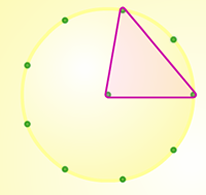Copyright © University of Cambridge. All rights reserved.
'Take a ... Geoboard' printed from https://nrich.maths.org/
Show menu
In addition to this article, you may like to read Manipulatives in the Primary Classroom which offers research-based guidance about using hands-on equipment in the teaching and learning of mathematics.
In this article, we draw your attention to a selection of NRICH tasks which make use of geoboards, all of which are contained within our Geoboards Feature. We outline how they can be used to develop a range of mathematical concepts plus an ability to work systematically and to think strategically. Geoboards are an invaluable manipulative for any classroom, at primary or secondary level, to support children's mathematical development and are often under-used. Here at NRICH we rate geoboards very highly!
Geoboards, sometimes called pegboards or pinboards, are boards with nails in a particular pattern. Usually, they are square or circular:


Square geoboards lend themselves to supporting children's understanding of concepts such as area and properties of shape. Circular geoboards are excellent for exploring angles, for example.
Ideally, learners will be able to experience working with 'real' geoboards in the classroom. However, if this is not possible, dotty paper could be used and/or these virtual geoboards. This free app may also be of interest. Of course, a virtual geoboard also enables you to set up your own questions for children to explore and for them to pose, and solve, their own questions too. (This NRICH interactive could also prove useful.)
Exploring area
Developing systematic working
Thinking strategically
Finally, in this Geoboard Feature, we offer you a linked pair of strategy games: Board Block and Board Block Challenge which both make use of the circular geoboard. These games combine reinforcement of properties of shape with higher-order thinking in terms of developing a winning strategy. A virtual geoboard comes into its own here as the game can be tailored to suit the players, for example by changing the number of points around the circle in each case. As with any game, it is important that learners are given time simply to play the game many times without worrying about strategy at first. (Our Strategy Games Feature explains further how you might support children to develop a winning strategy and how to structure a lesson using such a game.)
Geoboards and the new National Curriculum in England
Those of us teaching in England are currently (January 2014) in the transition phase between old and new national curricular. The new mathematics national curriculum contains more challenging content compared with the old version. In this context therefore, mathematical models are of even more importance to help children grasp concepts and have mental images to draw upon as the complexity of challenge develops. (To find out more about the importance of mathematical models, see the articles From Objects and Images to Mathematical Ideas and Models in Mind).
And finally....
Geoboards may well be a new manipulative for your school, or they may be one that is not yet exploited to its full potential across the curriculum and across year groups. Have you thought of using them to develop children's ability to work systematically, for example? Have a go at some of these NRICH activities and discover the power of the geoboard for yourself.
With thanks to Geoff Faux for his contributions on the creative and effective use of geoboards.
Here is a pdf version of this article.